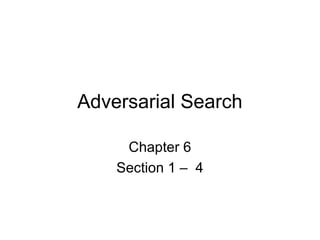
Adversarial Search and Pruning Techniques
- 1. Adversarial Search Chapter 6 Section 1 – 4
- 2. Outline • Optimal decisions • α-β pruning • Imperfect, real-time decisions
- 3. Games vs. search problems • "Unpredictable" opponent specifying a move for every possible opponent reply • Time limits unlikely to find goal, must approximate • •
- 4. Game tree (2-player, deterministic, turns)
- 5. Minimax • Perfect play for deterministic games • Idea: choose move to position with highest minimax value = best achievable payoff against best play • E.g., 2-ply game: • • •
- 7. Properties of minimax • Complete? Yes (if tree is finite) • Optimal? Yes (against an optimal opponent) • Time complexity? O(bm) • Space complexity? O(bm) (depth-first exploration) • For chess, b ≈ 35, m ≈100 for "reasonable" games exact solution completely infeasible • • • •
- 13. Properties of α-β • Pruning does not affect final result • Good move ordering improves effectiveness of pruning • With "perfect ordering," time complexity = O(bm/2) doubles depth of search • A simple example of the value of reasoning about which computations are relevant (a form of metareasoning) »» •
- 14. Why is it called α-β? • α is the value of the best (i.e., highest-value) choice found so far at any choice point along the path for max • If v is worse than α, max will avoid it prune that branch • Define β similarly for min » –
- 17. Resource limits Suppose we have 100 secs, explore 104 nodes/sec 106 nodes per move Standard approach: • cutoff test: e.g., depth limit (perhaps add quiescence search) • evaluation function = estimated desirability of position – –
- 18. Evaluation functions • For chess, typically linear weighted sum of features Eval(s) = w1 f1(s) + w2 f2(s) + … + wn fn(s) • e.g., w1 = 9 with f1(s) = (number of white queens) – (number of black queens), etc. •
- 19. Cutting off search MinimaxCutoff is identical to MinimaxValue except 1. Terminal? is replaced by Cutoff? 2. Utility is replaced by Eval Does it work in practice? bm = 106, b=35 m=4 4-ply lookahead is a hopeless chess player! – 4-ply ≈ human novice – 8-ply ≈ typical PC, human master – 12-ply ≈ Deep Blue, Kasparov – •
- 20. Deterministic games in practice • Checkers: Chinook ended 40-year-reign of human world champion Marion Tinsley in 1994. Used a precomputed endgame database defining perfect play for all positions involving 8 or fewer pieces on the board, a total of 444 billion positions. » • Chess: Deep Blue defeated human world champion Garry Kasparov in a six-game match in 1997. Deep Blue searches 200 million positions per second, uses very sophisticated evaluation, and undisclosed methods for extending some lines of search up to 40 ply. • Othello: human champions refuse to compete against computers, who are too good. • Go: human champions refuse to compete against computers, who are too bad. In go, b > 300, so most programs use pattern knowledge bases to suggest plausible moves. »»»
- 21. Summary • Games are fun to work on! • They illustrate several important points about AI • perfection is unattainable must approximate • good idea to think about what to think about • •
